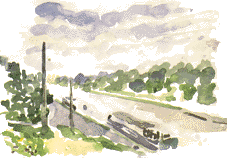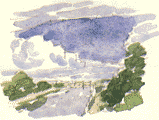Nature Diary Rocks History Gallery Home Page  Canal du Nord, Picardie
Canal du Nord, Picardie11.45 A.M.:THE CLOUD is thin enough, and broken, so, using our eclipse glasses, we are able to follow the progress of the Moon's disc. It becomes duller, but not dark, as the Sun is cut to a brilliant crescent.
    12.10 P.M.: The trees are as green and the sky as blue as on any, slightly dull, summer's day. We find it hard to imagine that the colour will drain away from the landscape in the next few minutes.
12.10 P.M.: The trees are as green and the sky as blue as on any, slightly dull, summer's day. We find it hard to imagine that the colour will drain away from the landscape in the next few minutes.
Totality12.23 P.M.: There's a cool breeze, then stillness, as the Sun is finally masked out. I'm impressed by the precision of it. The movements of the solar system somehow always seem to be 'up there'. A massive shadow rushing across the countryside brings it home that we really are on a planet that is reacting to the movements of Sun and Moon, and they to the Earth, part of a universe that each moment is changing.
The first we see of the returning Sun is the extraordinary brilliance of its rays as they reach us via a couple of valleys on the north east rim of the Moon, showing the diamond ring effect for a few seconds.
'Chauve-souris!', I yell, as I see silhouette flitting around the tall poplars. But it's not a bat, it's one of the martins returning. Two Herons are flying around, looking distinctly disorientated.
No more natural history, but we spend the rest of the day strolling around and sampling the cafes and restaurants of Peronne and Amiens.
Richard Bell, |

 Hoverflies and bees are busy feeding on the umbelled flower at my feet. A flock of House Martins wheels about above the canal-side Poplars.
Hoverflies and bees are busy feeding on the umbelled flower at my feet. A flock of House Martins wheels about above the canal-side Poplars. The clouds that were white are transformed into silhouettes in minutes. It's not as dark as night, as there is a distant reddish glow in the northern sky. There is no sound from the birds, not even an owl hooting.
The clouds that were white are transformed into silhouettes in minutes. It's not as dark as night, as there is a distant reddish glow in the northern sky. There is no sound from the birds, not even an owl hooting. A small corona glows pale orange.
A small corona glows pale orange.
 The light and colour soon return, but the cloud has built up now, and it stays quite cool.
The light and colour soon return, but the cloud has built up now, and it stays quite cool.